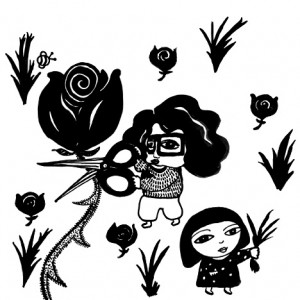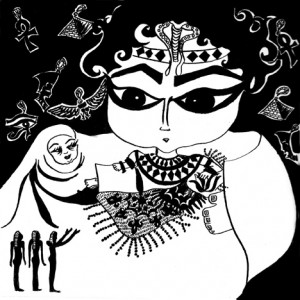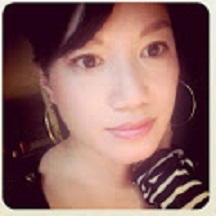Drawing from Life: Lisa Lim’s World in Words and Images
by Dawn Wing
Lisa Lim was born and raised in Queens, New York, where she grew up listening to magical storytellers like her Chinese grandmother and her Puerto Rican stepmother. She is the writer and illustrator of self-published graphic memoirs such as “Pots and Pans,” “My Egyptian Fortune Cookie,” and “Mi Madre.” Since then, her comics have been featured in Guernica magazine, Nashville Review, PANK magazine, and are available in the Museum of Chinese in America bookstore.
Of her art, Lim says, “Since I was a child, I’ve tried to capture their [my grandmother’s and my stepmother’s] colorful tales by writing short stories, novellas, and poems, but they always seemed to be missing that special something. That’s when I discovered comics.”
Ms. Lim just finished illustrating “Soma So Strange,” a children’s book by Carrie Rosten that came out this summer. In addition, Lim illustrated for a hip T-shirt company. While searching for her next creative adventure, Lim will continue to tell the funny and strange tales of her family. The Queens native generously took time out of her busy schedule to share her thoughts with APALA on being inspired by her family’s stories, the future of the comics industry and the importance of libraries/archives in the creative process. The article below is an excerpt from an interview I conducted in July 2013.

Dawn Wing (DW): What were your favorite books to read as a kid? What about as an adult?
Lisa Lim (LL): As a child, I was fascinated with “Grimms’ Fairy Tales.” I was spellbound by the gripping storylines and vivid imagery; how the stories blended innocence, violence, humor and imagination. The stories always elicited a strange mix of emotions in me. It was confusing yet exhilarating.
As an adult, I fell in love with Faulkner for the same reasons. Like Grimms’, Faulkner’s stories were dark, funny, unexpected, and always very visual. What I also loved about Faulkner was the musicality in his language and his use of stream of consciousness. I remember feeling I was almost in a state of meditation when reading his books. Like I was being hypnotized.
DW: How did these books and/or authors influence the work you do today?
LL: As a storyteller, they reinforced my own tales as a child. They made me feel okay about having grown up differently. Many parts of my childhood were grotesque, but beautiful and often hilarious. I found the same qualities in their tales. In my art, these authors also inspired me to think more visually and musically.
DW: What drew you to comics and writing?
LL: I was always writing stories, ever since I was a child. After college, I became a writer in advertising. During which I went to grad school for creative writing at City College. I was immersed in the reading and writing of words for so long. Eventually, words became the last thing I wanted to create. So began my creative Renaissance. I started taking every class from African dance to salsa to painting to improv theater to comics. I remember my first comics class. It was taught by Matt Madden and Tom Hart, two awesome professors at the School of Visual Arts. All of a sudden, I found myself combining stories with pictures, as I imagined them. Sometimes, words alone were not enough to fully evoke the imagery I wanted to express. Now, I had a completely new form of storytelling – comics – through which to tell my tales. This medium was liberating and so much fun.
DW: What are your hopes for the comics industry?
LL: My wish is for the comics industry to continue to thrive; that unique and experimental voices have a space in literature. While I appreciate traditional superhero tales, it is wonderful to see “alternative” comics flourishing on bookshelves. I especially hope that it continues to embrace memoir graphic novels such as “Persepolis,” “Blankets,” “Fun Home,” etc. One day, I hope to complete my own graphic novel about my family to share with readers everywhere.
DW: How does your diversity (cultural, educational, racial, gender, etc.) influence your work ethic?

LL: My melting pot family is a constant source of inspiration. My father and mother separated when I was young. My father, who is Chinese, married my stepmother, who is Puerto Rican. My mother, who is also Chinese, married my stepfather, who is Egyptian. I grew up in a family where English was drowned out by loud Chinese, Spanish and Arabic. Rituals of many cultures surrounded me: my stepmother making rose baths to cleanse evil spirits; my grandmother telling me tales of her youth in China; my father taking us to the Cypress Cemetery to burn origami money so our ancestors would have money to spend in heaven; my mother teaching me how to feed the moon gods during Mooncake Festival. My stepfather cooking fried kofta in the kitchen and all the smells of Middle Eastern food.
Since the age of 4, I lived with my father, his mother and my stepmother. My grandmother assumed the “tiger mom” role, wanting me always to do better and work harder. My Puerto Rican stepmother was the nurturing maternal force, full of love and warmth, always encouraging me to pursue my passions. So, between the cultures, I became a nice blend of practicality and creativity.
DW: Can you describe an instance when libraries and/or archives played a beneficial role in your work?
LL: Since my grandmother outlawed the air conditioner in our home, because she thought it caused arthritis, I spent most of my summers as a child in the Queens Public Library. It was an air-conditioned sanctuary for me. It was where I worked as an assistant in the Adult Learning Center for many years. It was also where I escaped to vastly different worlds from mine by reading and watching movies. One of my fondest memories as a child is watching Rocky IV in the basement library. Every week in the basement of the library, they would feature free movies. I also borrowed tons of movies from the library and became a student of film in this way. Immersing myself in cinema really helped me think visually, and it would later help me create comics because I thought of story as cinematic scenes versus pure narrative.
DW: What message would you give to librarians/archivists/writers/artists regarding their value in the field you work in?
LL: For writers and artists, the message I would give is inspired by a recent Robert McKee lecture I attended. When asked what to do in the face of the daunting creative block, he answered unequivocally, “the library.” He said to go to the library and you research your story from top to bottom. I couldn’t agree more. No matter how well you know your subject, digging into it deeper, learning details that no one else knows about your subject, that kind of curiosity is what makes your story authentic. You must know the world you create inside and out. And the library in all its resources can help you discover this world.
For librarians and archivists, thank you for being the nurturing bridge to this information. Without you, our stories would be less, in every way.
DW: What advice would you give young professionals, especially those from diverse backgrounds, who are interested in a career in comics/illustration?
LL: My biggest advice is to find multicultural authors whose works inspire you. Take a trip to your local library and research works that spark your imagination and interest. Then turn to your family for their own stories. Ask your grandparents, father, mother, aunts, uncles, sisters–anyone and everyone–about their lives. Their stories will surprise and inspire you. Remember that your cultural perspective is what can make your story unique. Through narrative and illustration, you can give readers a glimpse into your own world. Be part of the growing number of voices that represent multicultural storytelling. Be brave, curious, and always have fun.
To see more of Lisa Lim’s work, visit http://chineseladybug.carbonmade.com/
Her illustrations in the new book “Soma So Strange” can be purchased here: http://www.amazon.com/Soma-So-Strange-ebook/dp/B00ENNU8PM
Editing assistance provided by Melissa Cardenas-Dow and Jeremiah Paschke-Wood.

